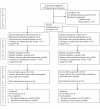The effectiveness of the Austrian disease management programme for type 2 diabetes: a cluster-randomised controlled trial
- PMID: 21054881
- PMCID: PMC2989935
- DOI: 10.1186/1471-2296-11-86
The effectiveness of the Austrian disease management programme for type 2 diabetes: a cluster-randomised controlled trial
Abstract
Background: Disease management programmes (DMPs) are costly and impose additional work load on general practitioners (GPs). Data on their effectiveness are inconclusive. We therefore conducted a cluster-randomised controlled trial to evaluate the effectiveness of the Austrian DMP for diabetes mellitus type 2 on HbA1c and quality of care for adult patients in primary care.
Methods: All GPs of Salzburg-province were invited to participate. After cluster-randomisation by district, all patients with diabetes type 2 were recruited consecutively from 7-11/2007. The DMP, consisting mainly of physician and patient education, standardised documentation and agreement on therapeutic goals, was implemented in the intervention group while the control group received usual care. We aimed to show superiority of the intervention regarding metabolic control and process quality. The primary outcome measure was a change in HbA1c after one year. Secondary outcomes were days in the hospital, blood pressure, lipids, body mass index (BMI), enrolment in patient education and regular guideline-adherent examination. Blinding was not possible.
Results: 92 physicians recruited 1489 patients (649 intervention, 840 control). After 401 ± 47 days, 590 intervention-patients and 754 controls had complete data. In the intention to treat analysis (ITT) of all 1489 patients, HbA1c decreased 0.41% in the intervention group and 0.28% in controls. The difference of -0.13% (95% CI -0.24; -0.02) was significant at p = 0.026. Significance was lost in mixed models adjusted for baseline value and cluster-effects (adjusted mean difference -0.03 (95% CI -0.15; 0.09, p = 0.607). Of the secondary outcome measures, BMI and cholesterol were significantly reduced in the intervention group compared to controls in ITT after adjustments (-0.53 kg/m²; 95% CI -1.03;-0.02; p = 0.014 and -0.10 mmol/l; 95% CI -0.21; -0.003; p = 0.043). Additionally, more patients received patient education (49.5% vs. 20.1%, p < 0.0001), eye- (71.0% vs. 51.2%, p < 0.0001), foot examinations (73.8% vs. 45.1%, p < 0.0001), and regular HbA1c checks (44.1% vs. 36.0%, p < 0.01) in the intervention group.
Conclusion: The Austrian DMP implemented by statutory health insurance improves process quality and enhances weight reduction, but does not significantly improve metabolic control for patients with type 2 diabetes mellitus. Whether the small benefit seen in secondary outcome measures leads to better patient outcomes, remains unclear.
Trial registration: Current Controlled trials Ltd., ISRCTN27414162.
References
-
- Dorner T, Rathmanner T, Lechleitner M, Schlogel R, Roden M, Lawrence K, Schwarz F, Kiefer I, Kunze M, Rieder A. Public health aspects of diabetes mellitus--epidemiology, prevention strategies, policy implications: the first Austrian diabetes report. Wien Klin Wochenschr. 2006;118:513–519. doi: 10.1007/s00508-006-0666-2. - DOI - PubMed
Publication types
MeSH terms
Substances
Associated data
LinkOut - more resources
Full Text Sources


